
Contains cover sheet, student example, and blank template.
- Subject:
- Elementary Education
- Material Type:
- Lesson Plan
- Author:
- Johanna Richards
- Date Added:
- 05/30/2019

Contains cover sheet, student example, and blank template.
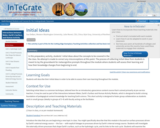
In this preparatory activity, students' initial ideas about the concepts to be covered in the module are collected and shared with the class. No attempt is made to correct any misconceptions at this point. The process of collecting initial ideas from students is meant to lay the groundwork for metacognitive prompts throughout the module where students self-assess their learning and how their knowledge changes from beginning to end.
(Note: this resource was added to OER Commons as part of a batch upload of over 2,200 records. If you notice an issue with the quality of the metadata, please let us know by using the 'report' button and we will flag it for consideration.)
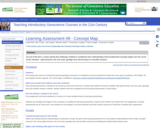
At the end of the semester, students are asked to create a concept map of the four main concepts covered over the duration of the course. They are provided with a grading rubric and 4 the main nodes that are required on the map (plate tectonics, the rock cycle, geologic time and scientific research). The four concepts can be arranged in any manner, and the connecting lines must be labelled with appropriate terms and examples. Students have the option of creating a paper map (11'' x 17'' or larger) or a digital map using a free software program, VUE.
(Note: this resource was added to OER Commons as part of a batch upload of over 2,200 records. If you notice an issue with the quality of the metadata, please let us know by using the 'report' button and we will flag it for consideration.)
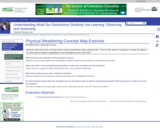
Students review and score a concept map for physical weathering using a grading rubric. They are then asked to reorganize or redraw the diagram to a form that you believe is appropriate to earn the highest score on the rubric.
(Note: this resource was added to OER Commons as part of a batch upload of over 2,200 records. If you notice an issue with the quality of the metadata, please let us know by using the 'report' button and we will flag it for consideration.)

In this activity, student teams create a knowledge map of the essential characteristics or factors of a planet with a habitable climate, identifying range of inputs, outputs and variables of a planetary environmental system. Identified characteristics are compared to extreme environments on Earth, such as the Antarctic or the Sahara desert, and are used to consider the real life challenge of searching for life in extreme environments. The resource includes a student data sheet, questions, teacher's guide and scoring rubric. This is Activity B of two activities in the first module, titled "Temperature variations and habitability," of the resource, Earth Climate Course: What Determines a Planet's Climate? The course aims to help students to develop an understanding of our environment as a system of human and natural processes that result in changes that occur over various space and time scales.

This unit is designed to engage students by introducing them to patterns in recent climate and investigating possible reasons for recent changes. Students work in small groups to plot and analyze real-world temperature data covering a decade, and use that information to make predictions about future climatic trends. Whole-class discussions illustrate the differences between short- and long-term trends. Students also analyze graphs of solar irradiance to begin to determine reasons for the observed increase in temperature, setting the stage for Unit 2, which examines the role of the atmosphere in controlling Earth's surface temperature.
(Note: this resource was added to OER Commons as part of a batch upload of over 2,200 records. If you notice an issue with the quality of the metadata, please let us know by using the 'report' button and we will flag it for consideration.)
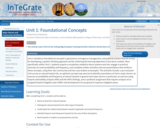
Unit 1 introduces foundational concepts in geoscience, emergency management, and political science that are critical for developing a systems thinking approach and for achieving the learning objectives in the storm module. More specifically, within Unit 1, students acquire a vocabulary related to storm systems and risk, engage in practical exercises on event probability and frequency, and complete written activities and oral presentations that reinforce these concepts, using their own community and two case studies as examples. The activities include: a pre-and post-Unit survey on natural hazard risk, an optional concept map exercise to identify associations of risk in major storms, an exercise on probability and frequency of natural hazards in general and major storms in particular, an exercise using hazard vulnerability analysis (HVA) and the HVA's findings, and a synthesis assignment that requires analysis of an assigned hazard mitigation plan (HMP) and development of a proposal to improve mitigation plans.
(Note: this resource was added to OER Commons as part of a batch upload of over 2,200 records. If you notice an issue with the quality of the metadata, please let us know by using the 'report' button and we will flag it for consideration.)

This introductory lesson will build the foundation for students to progress through the remaining units by defining food security and discussing the major factors contributing to food insecurity today (climate change, population growth, economic downturns, and change in global food consumption/wealth). Tied intimately to global food security is the concept of malnutrition. In this unit, students will engage with the three subcategories of malnutrition, which will provide an important basis for understanding the variation of food security across the globe and will challenge often held assumptions that food security only comes in the form of extreme hunger. Finally, students will be introduced to the global food system and will use the case study of chocolate to describe its components. As a formative assessment, students will take a five question multiple-choice quiz on the concept of malnutrition and the major causes of global food insecurity.
(Note: this resource was added to OER Commons as part of a batch upload of over 2,200 records. If you notice an issue with the quality of the metadata, please let us know by using the 'report' button and we will flag it for consideration.)
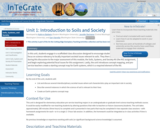
In this unit, students engage in a scaffolded class discussion designed to encourage students to move from a broad focus on science relevancy to locally important societal issues relevant to soils. They then relate what they learned during this discussion to the major assessment of this module, the Soils, Systems, and Society Kit (the Kit) assignment, and begin exploring potential focal issues for this assignment. Lastly, the unit introduces concept mapping, and pre-service teachers create a starting concept map for Earth systems, which is a required element of the Kit.
(Note: this resource was added to OER Commons as part of a batch upload of over 2,200 records. If you notice an issue with the quality of the metadata, please let us know by using the 'report' button and we will flag it for consideration.)
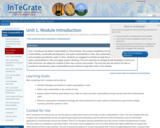
Unit 1 introduces the Water Sustainability in Cities Module. The content establishes the foundation definitions of sustainability, sustainable development, and water sustainability in cities. Key sustainability concepts are introduced and examples provided for water in cities. Students are engaged in activities to help them explore the definitions of water sustainability in cities and apply systems thinking. The unit materials are designed with flexibility in mind such that instructors can adapt the module to their own courses and context. The unit may also be used on its own to provide an introductory water sustainability lesson without using other units in the module.
(Note: this resource was added to OER Commons as part of a batch upload of over 2,200 records. If you notice an issue with the quality of the metadata, please let us know by using the 'report' button and we will flag it for consideration.)
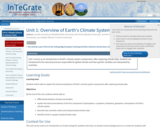
Unit 1 serves as an introduction to Earth's climate system components. After exploring climate data, students are introduced to the natural processes responsible for global climate and how specific variables are interpreted by scientists.
(Note: this resource was added to OER Commons as part of a batch upload of over 2,200 records. If you notice an issue with the quality of the metadata, please let us know by using the 'report' button and we will flag it for consideration.)
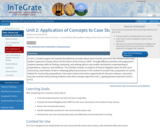
In Unit 2, students apply and evaluate foundational concepts about storm hazards and risk in the context of two cases studies: Superstorm Sandy (2012) and the Storm of the Century (1993). Through different activities and assignments, students develop skills for finding, evaluating, and relating data to case studies and build an understanding of preparedness, response, and resilience. The activities include: an analysis of hazard mitigation plans for their local community, examination of storm-related geophysical processes in the context of societal risks, preparation of a press release for community preparedness, and a peer review and revision opportunity for the press releases. Instructors may also end this unit by having students revise their concept maps from Unit 1, applying lessons learned in Units 1 and 2.
(Note: this resource was added to OER Commons as part of a batch upload of over 2,200 records. If you notice an issue with the quality of the metadata, please let us know by using the 'report' button and we will flag it for consideration.)
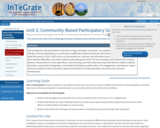
The introduction and examination of the food, energy, and water connection -- as a system in Unit 1 -- established the dictates of human dependency on and human modification of the environment. We continue a logical progression of what this means in Unit 2, with a focus on how people see, confront, and solve their resource challenges in the light of their need for affordable, accessible, healthy, sustainably-grown food. This unit introduces and explores the concepts, themes, and practices of: urban agriculture, urban farming, local food, food insecurity, food deserts, health & wellness education, community food gardens, community food dialogue, public policy, civic engagement, volunteerism, expert technical assistance, land reclamation, grants and incentives, entrepreneurship, and community economic development.
(Note: this resource was added to OER Commons as part of a batch upload of over 2,200 records. If you notice an issue with the quality of the metadata, please let us know by using the 'report' button and we will flag it for consideration.)
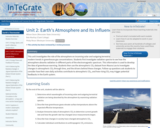
This unit investigates the role of the atmosphere on incoming solar and outgoing terrestrial radiation and analyzes modern trends in greenhouse gas concentrations. Students first investigate radiation spectra to see how the atmosphere absorbs radiation in different parts of the electromagnetic spectrum. This information is used to develop the idea of greenhouse warming. Students then use the atmospheric CO2 dataset from Mauna Loa to investigate changes in atmospheric CO2 through time, and the drivers behind these changes. Follow-up questions ask students to consider how their own daily activities contribute to atmospheric CO2, and how rising CO2 may trigger potential feedbacks in the Earth system.
(Note: this resource was added to OER Commons as part of a batch upload of over 2,200 records. If you notice an issue with the quality of the metadata, please let us know by using the 'report' button and we will flag it for consideration.)
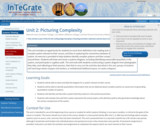
This unit includes an opportunity for students to move from definitions into reading and creating a diagram of a complex system relevant to their course, and then to exploring the connections between the components in the system. An exercise is provided to help students identify complex systems and their component parts from the world around them. Students will draw and revise a systems diagram, including identifying measurable quantities in the system, and participate in a gallery walk. The unit ends with students constructing a system diagram from photographs they take, and reflecting on their process. Note that to carry out the activities described in this unit, groups of students will need large sheets of paper and markers, or whiteboard/chalkboard space, to create a diagram.
(Note: this resource was added to OER Commons as part of a batch upload of over 2,200 records. If you notice an issue with the quality of the metadata, please let us know by using the 'report' button and we will flag it for consideration.)
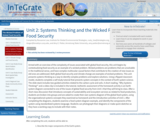
Armed with an overview of the complexity of issues associated with global food security, this unit begins by contextualizing food security as an example of a wicked problem. Wicked problems are problems that are unsolvable in the traditional sense, and have complex multiscalar causal factors that contribute to the creation of new issues as old ones are addressed. Both global food security and climate change are examples of wicked problems. This unit presents systems thinking as a way to identify complex problems and explore solutions. Using a flipped classroom model, students complete a self study tutorial that presents system concepts in the context of Earth system science. The slide stack includes two guided activities related to the carbon cycle and soils. A short reading, "Why Systems Thinking?" and a video clip is included in the tutorial. Authentic assessment of the homework activity is an Earth system diagram connected to one of the issues of global food security from Unit 1 that they will bring to class. After a short class discussion that introduces concepts of sustainability and ecosystem services as related to food production, students are broken into groups and are asked to create their own systems diagram of the global food system, using the organizational systems concepts they examined as homework and the introduction activities of Unit 1. After completing the diagrams, students examine a food system diagram example, and identify the components of the system using standardized systems language. Students can photograph their diagrams or make quick sketches so they have a working copy to include with their notes.
(Note: this resource was added to OER Commons as part of a batch upload of over 2,200 records. If you notice an issue with the quality of the metadata, please let us know by using the 'report' button and we will flag it for consideration.)
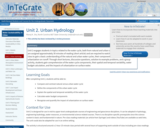
Unit 2 engages students in topics related to the water cycle, both from natural and urban system perspectives. Students are assigned approximately 30 minutes of reading (short article) and are required to watch a 15-minute video before class to gain a basic understanding of the natural and urban water cycles, their components, and the impact of urbanization on runoff. Through short lectures, discussion questions, solution to example problems, and a group activity, students gain comprehension of the water cycle components, their spatial and temporal variability, water budget calculation, and the impacts of urbanization on surface water.
(Note: this resource was added to OER Commons as part of a batch upload of over 2,200 records. If you notice an issue with the quality of the metadata, please let us know by using the 'report' button and we will flag it for consideration.)
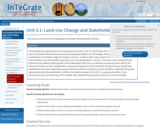
The example of a proposed land-use change that was used in Unit 2.3 is built upon here. The activities in this unit are meant to broaden the discussion beyond calculating quantitative run-off changes. Now we will also bring in consideration of a broader range of ecosystem services, as well as other ways in which a landscape can be valued, some of which may not be easily measured or even conceptualized as "services." Classroom time is devoted to the instructor and students exploring both (a) the stakeholders who have an interest in a particular place and (b) the various interests/uses those stakeholders may have for that place. By the end of the activity, the class should have identified several major stakeholder groups and several distinct ecosystem services. Students, organized into groups representing particular stakeholders, will then be tasked to prepare, for Unit 3.2, a group presentation, to be discussed on class on the last day of the module, that utilizes those ecosystem services as much as possible.
(Note: this resource was added to OER Commons as part of a batch upload of over 2,200 records. If you notice an issue with the quality of the metadata, please let us know by using the 'report' button and we will flag it for consideration.)
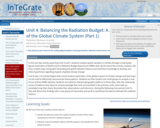
In this two-day activity spanning Units 4 and 5, students analyze spatial variation in climate through a map-based jigsaw exploration of NASA's Earth's Radiation Budget Experiment (ERBE) data. By the end of the activity, students will have created maps and graphs illustrating the global radiation balance and used their knowledge to develop and refine hypotheses regarding impacts of global climate change.
Unit 4 (day 1 of activity) begins with a brief student exploration of the global impacts of climate change and how maps can be used to effectively communicate these patterns. Students are then broken into small groups to analyze a map of one of three ERBE datasets. Students are asked to interpret geographic patterns in these data, infer the underlying causes of patterns they observe using knowledge they have accumulated in the previous units, and create an annotated map that clearly illustrates their observations and inferences. During the following class period (Unit 5), they will share their findings with a new group of classmates and work to synthesize the data to estimate the radiation balance.
(Note: this resource was added to OER Commons as part of a batch upload of over 2,200 records. If you notice an issue with the quality of the metadata, please let us know by using the 'report' button and we will flag it for consideration.)
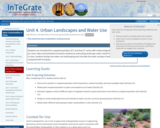
Students are introduced to evapotranspiration (ET) and how ET varies with meteorological factors and plant factors. A pre-class video and worksheet introduce students to estimating landscape water needs from ET and precipitation data. In class, students design low water-use landscaping and calculate the water savings of water-efficient landscaping compared with turf grass.
(Note: this resource was added to OER Commons as part of a batch upload of over 2,200 records. If you notice an issue with the quality of the metadata, please let us know by using the 'report' button and we will flag it for consideration.)